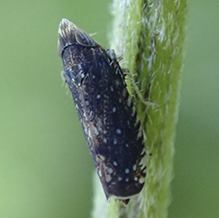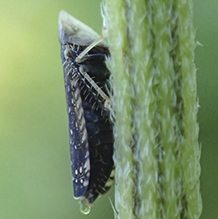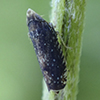yellow-faced leafhopper
(Scaphytopius frontalis)
Conservation • Description • Habitat • Ecology • Distribution • Taxonomy
Conservation Status |
|
|||||||
| IUCN Red List | not listed |
|||||||
| NatureServe | NNR - Unranked |
|||||||
| Minnesota | not listed |
|||||||
Description |
||
Yellow-faced leafhopper is a small, native, typical leafhopper. It occurs in the United States from New Hampshire to Georgia, west to Minnesota and Texas. It also occurs in Mexico and in southern Ontario Canada. It is common and widespread in the eastern United States, uncommon in southeastern Minnesota, where it reaches the western extent of its range. Adults and nymphs are found from June to October in a wide variety of habitats including grasslands, weedy areas, brushy areas, and forests. They feed on plant juices from a wide variety of plants, including goldenrod, grape, hemp, blackberry, clover, alfalfa, grasses, woody shrubs, and oak trees. Males are ⅛″ to 3⁄16″ (3.8 to 4.5 mm) in length, females are ⅛″ to 3⁄16″ (4.1 to 5.0 mm) in length. The body is black or very dark brown. It is salted with pale brown flecks and has numerous whitish spots. The head is black. The top of the head (crown) is black or dark brown with whitish markings. It is relatively short, and it projects well forward in a long, narrow angle to a blunt point. When viewed from the side it is flat. There is a short longitudinal dash at the tip. Behind this, there is a wedge-shaped mark near each lateral margin, and two longitudinal dashes near the middle. Taken together, the four marks form a transverse band in front of the eyes. The cheeks (genae) are broad. They extend up behind the eyes and can be seen when viewed from above. The face is mostly yellow, dark just on the margins. The plate on the first segment of the thorax (pronotum) is convex on the front margin, concave on the rear margin. It is black and there are usually five faint, white, longitudinal lines. The plate between the wing bases (scutellum) is black with four spots near the base, a spot on each lateral margin at the midpoint, and a spot at the tip. The forewings (hemelytra) are black or very dark brown. They are marked with scattered, whitish dots and dark, wavy, worm-like lines (vermiculations). There are two crossveins. In the basal area there are nine or ten veinlets that are bent backwards (reflexed) to the leading edge (costal margin). |
||
Size |
||
Male total length: ⅛″ to 3⁄16″ (3.8 to 4.5 mm) Female total length: ⅛″ to 3⁄16″ (4.1 to 5.0 mm) |
||
Similar Species |
||
| This is the only blackish species with a short crown and a yellow face. | ||
Habitat and Hosts |
||
Grasslands, weedy areas, brushy areas, and forests A wide variety of plants, including goldenrod, grape, hemp, blackberry, clover, alfalfa, grasses, woody shrubs, and oak trees |
||
Ecology |
||
Season |
||
June to October |
||
Behavior |
||
Yellow-faced leafhopper is active at night and will come to lights. |
||
Life Cycle |
||
|
||
Nymph Food |
||
Juices from a wide variety of plants |
||
Adult Food |
||
Juices from a wide variety of plants |
||
Distribution |
||||
|
Sources Medler, John T. (1942). The leafhoppers of Minnesota. University of Minnesota. Minnesota Agricultural Experiment Station. Retrieved from the University of Minnesota Digital Conservancy, https://hdl.handle.net/11299/204089. |
|||
| 10/28/2023 | ||||
Occurrence |
||||
|
||||
Taxonomy |
|||
Order |
Hemiptera (True bugs, Hoppers, Aphids, and Allies) | ||
Suborder |
Auchenorrhyncha (true hoppers) | ||
Infraorder |
Cicadomorpha (spittlebugs, cicadas, leafhoppers and treehoppers) | ||
Superfamily |
Membracoidea (leafhoppers and treehoppers) | ||
Family |
Cicadellidae (typical leafhoppers) | ||
Subfamily |
Deltocephalinae | ||
Tribe |
Scaphytopiini | ||
Genus |
Scaphytopius | ||
| Subgenus | Cloanthanus | ||
Synonyms |
|||
Cloanthanus frontalis Nasutoideus frontalis Platymetopius albonotatus Platymetopius albopunctatus Platymetopius frontalis |
|||
Common Names |
|||
yellowfaced leafhopper yellow-faced leafhopper |
|||
Glossary
Costal margin
The leading edge of the forewing of insects.
Gena
In insects: The area between the compound eye and the mandible; the cheek. In birds: The area between the the angle of the jaw and the bill; the feathered side (outside) of the under mandible. Plural: genae.
Hemelytron
The forewing of true bugs (order Hemiptera), thickened at the base and membranous at the tip. Plural: hemelytra.
Pronotum
The exoskeletal plate on the upper side of the first segment of the thorax of an insect.
Visitor Photos |
|||||
Share your photo of this insect. |
|||||
| This button not working for you? Simply email us at info@MinnesotaSeasons.com. Attach one or more photos and, if you like, a caption. |
|||||
Babette Kis |
|||||
Scaphytopius frontalis yellow-faced leafhopper Scaphytopius frontalis, yellow-faced leafhopper, Barnes Prairie, Racine Co., WI, photographed August 3, 2022. |
 |
||||
 |
|||||
MinnesotaSeasons.com Photos |
|||||
|
|||||

Slideshows |
||

Visitor Videos |
|||
Share your video of this insect. |
|||
| This button not working for you? Simply email us at info@MinnesotaSeasons.com. Attach a video, a YouTube link, or a cloud storage link. |
|||
Other Videos |
|||


Created: 10/28/2023
Last Updated:

